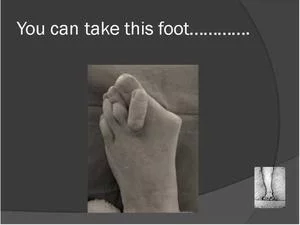Fat Pad Augmentation
Over the years scientists have tried to come up with a way to replace the fat pads in the foot. This has been very difficult because of the weightbearing nature of the foot. Some patients will continue to have pain in the heel or ball of the foot even when they wear good shoes with orthotics, these people suffer from fat pad atrophy of the foot, unfortunately we cannot stop mother nature, throughout time the fat pad in the foot will decrease and bone to skin contact will increase and cause pain.
The best procedure for these patients are fat pad augmentation, there are two types of fat pad augmentation, The first is your own fat can be placed or repositioned into the foot. The second option is to use synthetic grafts to cushion the area. On your consultation we will describe which procedure you can benefit from.
You can take this foot . . .

To this foot . . .

To this toe . . . Without going to the operating room

GraftJacket Fat Pad Augmentation Procedure
Dr. Devon Glazer was the second foot surgeon in the U.S. to publish and perform the GraftJacket FAT PAD AUGMENTATION procedure.
Are you tired of your calluses?
Ask Dr. Glazer if you are a candidate for the insurance covered Fat Pad Augmentation procedure.

Fat Pad Augmentation – A Patient’s Experience
“I am writing to you to sincerely thank you for “installing the fat pad” in my big toe. I no longer experience blisters, red spots, or open sores as I did before. Additionally, I no longer feel like I’m off balance when I walk and my shoes fit better. So again, thank you for the “fat pad”!!!!! – N.G.
We offer conservative treatment options too!
Many foot, ankle, knee and back pains can be relieved by a custom orthotic prescribed by Dr. Glazer without any need for surgery.
Most times Orthotics are covered by insurance through a foot and ankle physician.
Your satisfaction and health ate our number one goal. Thank you for choosing us for your health care needs!

